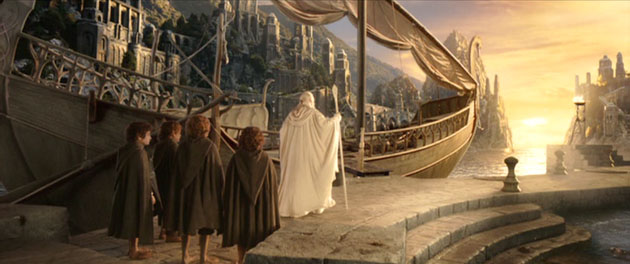Grant Major

We’re not creature designers but we had to do it for the sake of knowing how it interacted with things. It had direct implications on how we built the boat, and how the boat was all geared up to tip over. We also built a big Meg head piece that was suspended on the back of the boat.
AS: And you constructed water tanks for these sequences to be shot in?
GM: New Zealand at that point didn’t have a water tank for filming. We looked around a lot of coastal areas to see where we could put it but because we would have had to commute too far from Aukland we ended up building it in our backlot. And we built a huge greenscreen wall behind it. We built the whole thing from scratch. It’s still there actually! Avatar II used it a little while ago. We also built a huge indoor tank for all the underwater sequences. They had to be built because we needed access to the top, access windows through the bottom of the tanks, and we needed to be able to get all the way around the tanks to be able to light them. We also had to be able to control the temperature for the actors.
AS: Any advice for a production designer who has been designing smaller movies and then suddenly gets to design a film with a huge budget?
GM: An equal amount of creativity goes into a big-budget film but the organization and the stamina is different. Small movies tend to be fairly short and sharp in terms of the prep and the shoot, because of the budget. You don’t tend to travel far from home. On the big shoots you have to be able to take on the right people to be able to divvy up the work load. The supervising art directors are great at organizing studios and taking on crew. On a small movie you do all that yourself. On these big, sprawling movies you need to bring on more crew and you have to be prepared to travel. You have a lot of different jobs going on in different parts of the country or different parts of the world. So you find yourself commuting a lot more between these places. You have teams of people here, there, and everywhere. There are a lot more logistics involved, in terms of getting on top of mountains and out into the middle of lakes. The canvas is way bigger with more interesting and extreme environments. You need to be able to focus on just the most important production design elements and then bring on people who can take the weight of the organizational side.
AS: Often I’m impressed with the sheer number of art directors on bigger movies.
GM: You have to divide up the film, don’t you? On Mulan, for example, we were splitting ourselves between the studio and China and the South Island of New Zealand. We had three geographical areas that we were working in. And then within that there were big sets to be built at various places so I had a different art director dealing with each of those areas and within those areas, assistant art directors doing specific things.
AS: What was your experience working in China?
GM: It was interesting. They have quite large backlots that all specialize in particular time periods for their movies. Our film was based in the Tang dynasty so we were looking at the Tang dynasty backlots. But the backlots over there are not exclusively for filming. They often have them as theme parks and it’s a way a lot of the Chinese learn their own history.
Tom, this is a wonderful blog, thanks for the info.
Do you have any advice for aspiring production designers? I live in Philadelphia and recently finished architecture school but I very much want to design films.
Glad to hear you like the blog! The best advice I’ve found is to just get out there and start doing it. Work on low budget videos, short films, commercials, anything you can get your hands on for low money. A lot of these directors will call you when they start doing features. And then call you again when the features get bigger budget. K.K. Barrett started with commercials and music videos for Spike Jonze, Grant Major started on smaller movies with Peter Jackson, and Jack Fisk rented a van and brought his own tools out to Colorado to go do Terence Malick’s Badlands. He not only found an auteur to work with throughout his career, he also met his future wife, Sissy Spacek.
Also, you may want to move to LA or New York or anywhere there are schools like USC, AFI, NYU where talented directors are just starting out and looking for designers….
Pingback: STH032: Gandalf the Stern « SQPN: Secrets of The Hobbit
Thanks so much for the response.
I’m actually working on a short film with an old friend of mine who just graduated from USC and is trying to become a director so I guess I am on the right track! He lives in and will be shooting the film in San Diego but we’ve been able to work together so far by way of email and it’s been a lot of fun. I guess I will see what comes of it! If nothing else I’ll have some material to add to my portfolio.
Thanks again!
Pingback: Laurence Bennett
Pingback: Rick Heinrichs
Pingback: STH032: Gandalf the Stern - SQPN.com